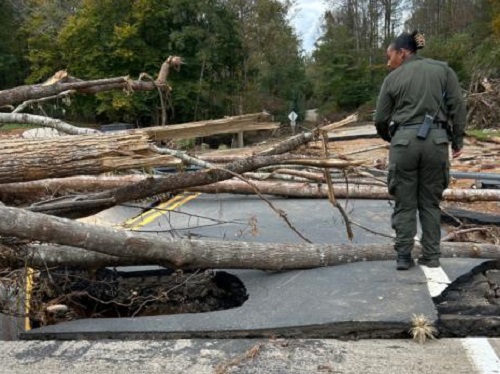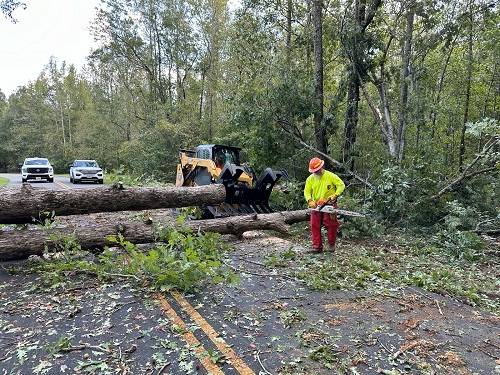The Federal Highway Administration recently made $43.1 million in Emergency Relief or ER funds available via its “quick release” process to the U.S. Forest Service and the National Park Service to cover the costs of Hurricane Helene recovery efforts across four states.
[Above photo by the National Park Service]
The agency said in a statement that ER funding will support critical repair work to bridge and roadway infrastructure in national forests and parks across North Carolina, South Carolina, Tennessee, and Virginia – including the Blue Ridge Parkway in North Carolina, one of the most visited national parks in the nation.

In late September, Hurricane Helene’s heavy rainfall, flooding, and strong winds severely damaged roads in the national forests and parks across that four state region; triggering significant landslides and destroying infrastructure, making it difficult for emergency vehicles and utility crews to travel into the area to make essential repairs.
Of the requested $43.1 million in ER funds, $18.1 million will be used by the U.S. Forest Service to re-open and re-establish the roads and bridges in the national forests in the Carolinas, Tennessee, and Virginia. Another $25 million will be distributed to the National Park Service for emergency repairs to the Blue Ridge Parkway in North Carolina.
Other repairs targeted by that ER funding include:
- $5.1 million for emergency repairs in the Pisgah and Nantahala national forests in North Carolina.
- $1.25 million in emergency repairs in Francis Marion and Sumter national forests in South Carolina.
- $5.25 million for emergency repairs in Cherokee National Forest in Tennessee.
- $6.4 million for emergency repairs in George Washington and Jefferson national forests in Virginia.
Additional funds to repair the damage across these four states, currently estimated to be more than $1 billion, will be supported by the ER program through nationwide funding allocations, FHWA said.
State departments of transportation in areas affected by Hurricane Helene continue to engage in a host of recovery efforts.

For example, the North Carolina Department of Transportation expects a stabilization project securing the westbound lanes of I-40 in Pigeon River Gorge to be completed over the next few weeks, where heavy flooding washed away the interstate’s eastbound lanes in four long swaths during the immediate aftermath of the storm.
The agency said in a statement that two-way highway traffic through the gorge should be restored by January 1, 2025.
NCDOT also recently saluted the many public and private partners it is working with to restore roadway infrastructure in Western NC, where the agency has over 2,100 personnel engaged in ongoing recovery operations.
 Nation
Nation
Registration Open for AASHTO’s Winter Rail Meeting
December 19, 2025 Nation
Nation

